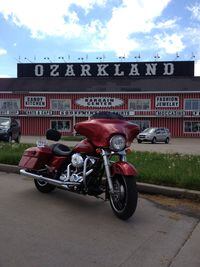[If Ducati's mechanical DNA makes its motorcycles inherently suited for carving up chicanes at Italian race circuits like Monza or Mugello, and BMW's big-bore touring bikes seem like they were born for the autobahn, the Midwestern United States is where a Harley-Davidson motorcycle comes into its own. It certainly felt that way today, unrolling 300-plus miles of rolling green farmland—punctuated by the occasional steel-girder bridge—connecting the dots between Kansas City and Alton, Illinois, aboard a 2013 Harley-Davidson Street Glide. Hammering along at 80 mph, the Twin Cam 103 motor barely breathing in its overdriven 6th gear, the Street Glide I rode felt like it could go on forever down these long, straight, flat roads. At one point I rode almost five miles no-handed, with the cruise control locked at 80 mph, marveling at the Street Glide's rock-solid, unwavering stability. The American spirit, writ open on two wheels.
Today began at a literal Harley-Davidson birthplace—the Vehicle and Powertrain Operations factory located in Kansas City, Missouri. This is where all Harley-Davidson Sportster, Dyna, and V-Rod models are built—the V-Rod's liquid-cooled Revolution powertrain is made here as well, making this the only one of The Motor Company's facilities that builds both engines and complete bikes under the same roof. Constructed in 1996 at a cost of $120 million—$83 million of which was dedicated to a state-of-the-art paint facility—the 350,000 sq.-ft. Kansas City operations employs 950 people working two shifts performing all necessary fabrication, assembly, and painting tasks to build the three model lines.
[Journalists were treated to an expanded version of the new-ish "Steel Shoe" plant tour, which offers any interested visitor an inside look at how some of Harley-Davidson's most popular models—including all but one of the Dark Customs (the Softail Slim is built in York, PA)—are built. It's actually an amazing process, mixing the cutting edge manufacturing technology with a surprising amount of old-school human labor. One on hand, there are an awful lot of robots and an amazing array of lasers—and if you've never seen laser welding, which uses an 18,000-watt beam of focused light to fuse two pieces of steel, like, for example, two halves of a fuel tank, it really is amazing and almost magical. But all of this modern technology is balanced with a remarkable amount of elbow grease. Though robots weld the bulk of the frames, each one is painstakingly inspected and finish-welded by hand; same with the fuel tanks, which are also individually pressure tested, in a basin sink, by quality control staff. And despite the $83 million worth of cleaning, etching, painting, and powder-coating apparatus installed in Kansas City, rest assured that your Sporty, Dyna, or V-Rod paint was buffed, polished, and finished by human hands.
[For a company that makes as many bikes each year as Harley-Davidson does—nearly 240,000 in 2012—an amazing amount of careful, painstaking hand labor goes into each one. It's enough to make any American proud of our biggest motorcycle manufacturer. If you should find yourself in Kansas City—or York, PA, or Milwaukee, where Harley-Davidson's other major manufacturing operations are located—do yourself a favor and set aside a few hours to take a tour. It's a process worth seeing up-close.














/cloudfront-us-east-1.images.arcpublishing.com/octane/QSTCM6AVEZA5JJBUXNIQ3DSOF4.jpg)
/cloudfront-us-east-1.images.arcpublishing.com/octane/U4I7G625B5DMLF2DVIJDFZVV6M.jpg)
/cloudfront-us-east-1.images.arcpublishing.com/octane/B6XD6LS6IVCQPIU6HXDJSM3FHY.jpg)
/cloudfront-us-east-1.images.arcpublishing.com/octane/ICL63FEDDRDTTMINYICCEYGMDA.jpg)
/cloudfront-us-east-1.images.arcpublishing.com/octane/FCGZHQXRBZFLBAPC5SDIQLVF4I.jpg)
/cloudfront-us-east-1.images.arcpublishing.com/octane/WNOB6LDOIFFHJKPSVIWDYUGOPM.jpg)

/cloudfront-us-east-1.images.arcpublishing.com/octane/X33NU3E525ECRHXLNUJN2FTRKI.jpg)
/cloudfront-us-east-1.images.arcpublishing.com/octane/6KKT5NNL2JAVBOXMZYS5ZO76YA.jpg)
/cloudfront-us-east-1.images.arcpublishing.com/octane/J5RKG5O455GMPGQRF2OG6LRT7A.jpg)
/cloudfront-us-east-1.images.arcpublishing.com/octane/GX2CIZKQVRH2TATDM26KFG2DAE.jpg)
/cloudfront-us-east-1.images.arcpublishing.com/octane/ZWIDYSAKQZHD5BHREMQILXJCGM.jpg)
/cloudfront-us-east-1.images.arcpublishing.com/octane/CYUHJZCTSJCH3MRAQEIKXK7SCQ.jpg)
/cloudfront-us-east-1.images.arcpublishing.com/octane/LKOFINY56FCXJCANJ5M7ZDQUBY.jpg)
/cloudfront-us-east-1.images.arcpublishing.com/octane/4NBPDACMWJH63JQYJVK3QRBDZI.jpg)
/cloudfront-us-east-1.images.arcpublishing.com/octane/KKHQHRR3FJGX7H2IPU6RALMWG4.jpg)

/cloudfront-us-east-1.images.arcpublishing.com/octane/5IOFS5JAE5FOXMNA23ZRAVVYUU.jpg)
/cloudfront-us-east-1.images.arcpublishing.com/octane/CGXQ3O2VVJF7PGTYR3QICTLDLM.jpg)

/cloudfront-us-east-1.images.arcpublishing.com/octane/OQVCJOABCFC5NBEF2KIGRCV3XA.jpg)
/cloudfront-us-east-1.images.arcpublishing.com/octane/OPVQ7R4EFNCLRDPSQT4FBZCS2A.jpg)
/cloudfront-us-east-1.images.arcpublishing.com/octane/YBPFZBTAS5FJJBKOWC57QGEFDM.jpg)
/cloudfront-us-east-1.images.arcpublishing.com/octane/W5DVCJVUQVHZTN2DNYLI2UYW5U.jpg)